New
River Ponds & Imperial Valley
Oct
28, 2001
-
75-90
degrees
We monitored the New River Wetlands Project and checked out some hot
spots in the valley.
89 species (list follows at end of page)

Click on
thumbnail pictures for full-sized shots.
|
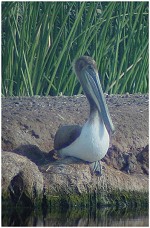
Brown Pelican
|
Suzanne and I
picked up Bob at his place, and then headed directly to the New
River Imperial Ponds to survey the birds
there. The Brown Pelican from several weeks ago was still
around, as well as two new additions to the site: a Common
Loon and a Rock Wren. Green Herons and egrets were
everywhere and Bob also spotted a Least Bittern. |
|
|
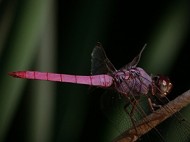
Roseatte Skimmer dragonfly
The
dragonflies and damselflies were beautiful and prolific, and we
spent some time examining and photographing them. |

Breeding Damselflies
|
|

Lewis' Woodpecker
|
After chef Bob's fine carne asada lunch, we went
looking for Gila Woodpeckers to show Suzanne. While
searching in the west part of Brawley, Bob spotted a Lewis'
Woodpecker. This picture of the woodpecker (as well as many others
on this page) was taken by Bob from a quarter mile away
using his new digital Nikon camera through his Kiowa scope. How? |
|
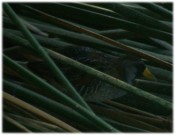
Sora in the bulrushes |
At the Brawley Ponds I spied a Sora lurking next to
an island of bulrushes, and Bob was able to capture it on
"film." Before we had completed our survey of this
site we'd also seen both Least and American Bitterns. |
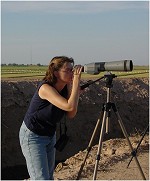
Suzanne |
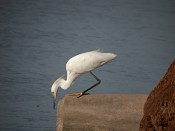
Snowy Egret looking for a meal
|
|
One of the hot spots of the Imperial Valley is the Osterkamp Ponds,
off McConnell Road. In the evening you can watch the
Sandhill Cranes coming in to roost, or watch them leaving in the
morning. Last year a small flock of White-fronted Geese
wintered there, and this year they're back. Other birds we
saw included waders, shorebirds, sparrows, and a nearby Peregrine
Falcon.
|
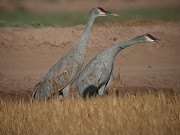
Sandhill Cranes |
At last count there were some 285 cranes roosting in
these ponds and fields. These two individuals were feeding
and posed for several shots before flying off. |
Along with Cattle Egrets, Long-billed Curlews, and White-faced Ibis, this
Swainson's Hawk was taking advantage of an irrigated field to hop around and
snap up insects. Though not usually found in the U.S. during the
colder months, occasionally this bird of prey finds enough food to
spend the whole winter here.
|
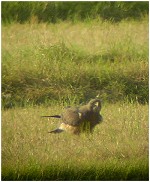
Swainson's Hawk
insect-catching
|
The setting sun saw us driving back to Yuma, already looking forward to our next
venture into the Imperial Valley!
|
|